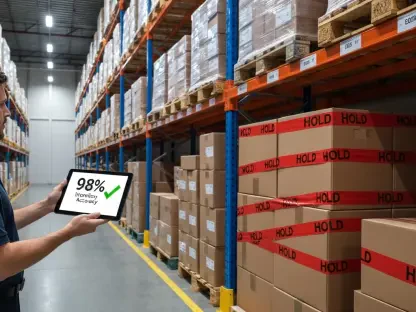In the U.S., transloading, the process of transferring cargo from one mode of transportation to another, is making a strong comeback in the logistics sector. The practice is increasingly preferred as it offers flexibility in shifting goods between trucks, trains, and other vehicles, effectively optimizing shipping routes and costs. The uptick in transloading is due in part to fluctuating fuel prices, the pressing need for quicker delivery times, and the constant search for cost-effective shipping methods. Additionally, the rise of e-commerce has placed a premium on efficient, multi-modal supply chains that can adapt to diverse delivery demands. Supply chain stakeholders are thereby motivated to reevaluate and adopt transloading strategies, recalibrating the traditional freight transport modalities. As a result, we’re witnessing a significant shift in how goods are being moved across the nation, leading to potential changes in infrastructure investment, the policy-making process, and operational logistics planning.
The Rising Tide of Transloading in the US
Redirected Shipping Routes and West Coast Resurgence
East Coast and Gulf port labor strike threats, along with route changes like those in the Red Sea, have driven U.S. imports toward West Coast ports. These shifts signal the vulnerability of conventional trade corridors to external factors, both climatic and geopolitical. The Panama Canal has also played a role with its drought-induced limitations, further steering shipping toward the Pacific shoreline.Amid these changes, logistics firms are focusing more on West Coast facilities, which encourages transloading activities where goods are transferred between trains and trucks, adapting to the new shipping patterns. This move not only increases the operational demand for West Coast ports but also prompts a wider distribution of goods, enhancing efficiency and supply chain flexibility nationwide. With the West Coast’s logistics prospects on the rise, the industry is adapting to the evolving dynamics of global trade routes and environmental challenges.
Transloading’s Economic Appeal to Logistics Companies
Freight transportation businesses like CH Robinson and DHL are increasingly leveraging transloading to drive economic efficiency. This logistics strategy reduces reliance on containers—cutting significant costs, which is crucial in the thin-margin industry. It also addresses container shortages and reduces fuel expenses since it typically involves shorter truck trips from rail centers to destinations.This shift to transloading offers a strategic advantage, enhancing operational efficiency for logistics providers and benefiting their smaller clients with lower transportation costs. It’s a financially shrewd move that is becoming more attractive for logistics companies aiming to sustain and improve their profitability during challenging times. As these firms adapt to transloading, they’re finding a competitive edge by streamlining services and managing resources more effectively.
Wall Street’s Watchful Eye on Transloading
Transport Stocks and Transloading’s Impact
The uptick in transloading hasn’t gone unnoticed by Wall Street. Analysts are keeping a close watch on transport stocks that could potentially benefit from this burgeoning trend. Companies like Union Pacific and J.B. Hunt find themselves at the center of interest, as investors speculate that the increased volume of goods moving through West Coast ports—and thus requiring transloading services—will enhance these companies’ market positions.Despite this hopeful sentiment, there’s an air of caution due to the ongoing recovery from a freight recession. Industry heavyweights such as Schneider and Knight-Swift are being closely monitored to gauge their ability to capitalize on this logistics strategy and navigate through lingering economic aftershocks. Investors are considering the resilience and adaptability of these companies as crucial factors in determining their appeal in the face of evolving transportation dynamics.
Transloading – A Strategic Shift in Supply Chain Management
Supply chain experts are in agreement: the increasing reliance on transloading is indicative of a permanent shift toward more varied port usage and smaller, more targeted freight loads. This strategic diversification offers a buffer against logistics disruptions and is a savvy play towards supply chain agility. With freight being divided overseas and sent to multiple ports closer to end destinations, importers stand to save on both time and expenses.This pivot towards transloading is part of a strategic overhaul within the supply chain sector, reflecting a preemptive response to current global trade challenges. By dismantling the monolithic approach to freight transport and embracing a more modular method, supply chains are becoming more resilient and flexible—a transformation that reflects the industry’s constant pursuit of efficiency.
Benefits and Adaptations in the Logistics Landscape
Operational Advantages for Clients
Logistics experts concur that transloading offers multiple advantages to clients. For one, it facilitates significant cost savings, which is especially crucial for smaller businesses that might not have the same financial buffers as larger corporations. Additionally, the flexibility inherent in transloading practices ensures that even the most stringent shipping schedules can be met with greater efficiency.The ability to move goods between various transport modes seamlessly means clients can expect faster delivery times and reduced waiting periods for their cargo. This operational versatility is vital in a market that increasingly demands speed and reliability in equal measure. As logistics companies expand their transloading services, they’re setting a new standard for what clients can expect from the transportation of their goods.
The Geographical Spread of Transloading
The expansion of transloading activities isn’t confined to the U.S.; Mexico is also witnessing a surge in its cross-border trade operations. This uptick is a boon for businesses entrenched in cross-border logistics, unlocking opportunities for expansion and leading the market.These trends underscore the vital role of trade cooperation within North America. By streamlining the transfer of goods over national boundaries, transloading is becoming a pivotal element in enhancing just-in-time delivery systems amidst the intricacies of global commerce. The process not only addresses logistical challenges but also synchronizes supply chain activities across the continent, fostering economic integration and providing competitive advantages to proactive firms. As trade volumes swell, companies adept in transloading are poised to excel, leveraging the interconnectedness of North America’s trade ecosystem.
Transloading’s Broader Implications for Sustainability
Environmental and Economic Considerations
Transloading is gaining traction as a method that not only boosts logistical efficiency but also champions eco-friendliness in transport. By streamlining the shipping process, fewer trips are necessary, leading to reduced emissions and fuel use. This synergy between economic gains and environmental care is now a benchmark for sound logistics.In a fiscal sense, transloading maximizes the use of transport assets. Trains cover the bulk of the journey, while trucks handle short, final stretches, optimizing the cost-service ratio in transport. This approach not only ensures current logistical needs are met but also strengthens the sector’s future, aligning business objectives with a commitment to environmental sustainability. The transloading strategy is key for creating a flexible and durable logistics network that is both environmentally and economically sustainable.
The Future of Freight Transportation
The Strategic Advantage of Transloading
Transloading is set to revolutionize the logistics sector, especially with an early peak shipping season on the horizon. Forward-thinking logistics firms that invest in transloading will likely gain a significant advantage due to its capacity to boost efficiency and flexibility in supply chain management. This method is on track to become a key element of innovative logistics strategies, offering an effective solution to current supply chain obstacles. The integration of transloading services is expected to dramatically alter the way freight is transported, signifying a shift towards more agile and responsive logistical operations. As the industry evolves, the strategic importance of transloading becomes evident—it’s not just a temporary fix, but rather a fundamental aspect of contemporary logistics planning for the future.









